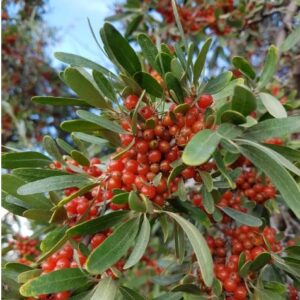Description
Red Oak Tree (Quercus rubra) – 1 Yr Old Seedling
Overview
The Red Oak (Quercus rubra) is a robust and fast-growing deciduous tree known for its stately form and vibrant fall foliage. With its distinctive red leaves and strong wood, this tree is a favorite in both urban and rural landscapes. Red Oak is an excellent shade tree, offering shelter and beauty, while its acorns provide food for wildlife. This 1-year-old seedling is perfect for planting in your yard, park, or forested area, where it will grow into a magnificent tree for generations to come.
Native Range
Native to the eastern and central parts of North America, the Red Oak is commonly found in forests, woodlands, and along stream banks in regions from southern Canada to northern Mexico.
Growth and Form
- Height: Grows approximately 18–24 inches per year, reaching 60–75 feet at maturity.
- Spread: Mature Red Oaks have a canopy spread of 45–60 feet.
- Growth Rate: Moderate to fast, making it an excellent choice for those looking for a quicker-growing shade tree.
- Foliage: Dark green, deeply lobed leaves that turn a striking red to reddish-brown in the fall.
- Bark: Grayish-brown bark with ridged furrows that become more pronounced with age.
Ecological Benefits
- Wildlife Habitat: Red Oak acorns are an important food source for squirrels, deer, and various bird species. The tree also provides habitat for many animals.
- Shade and Cooling: With its large canopy, the Red Oak is ideal for providing shade in summer, helping reduce temperatures in urban settings.
- Soil Health: Fallen leaves add nutrients to the soil, promoting healthy ecosystems and benefiting surrounding plant life.
Red Oak Hardiness and Climate Tolerance
- Hardiness Zones: 3–8, making it suitable for a wide range of climates, from cold northern winters to more temperate southern regions.
- Cold Tolerance: Hardy and can withstand cold temperatures down to -30°F (-34°C).
- Drought Tolerance: While it prefers regular moisture, once established, the Red Oak is relatively drought-tolerant.
- Soil Preferences: Thrives in well-drained, loamy soils but can adapt to a variety of soil types, including clay and acidic soils.
Red Oak Planting and Care
- Planting Location: thrives in full sun but can tolerate some light shade. Plant in areas with good air circulation and space for future growth.
- Watering: Regular watering is essential in the first few years, especially during dry spells. Once established, the tree requires less frequent watering.
- Fertilization: A balanced, slow-release fertilizer in spring can help promote healthy growth during the early years.
- Pruning: Minimal pruning required. Remove dead or damaged branches in late winter or early spring. Avoid heavy pruning during the growing season.
Uses
- Timber: The strong, durable wood is used in furniture making, flooring, cabinetry, and even barrels for aging wine and whiskey.
- Shade and Landscaping: Red Oak is a popular landscaping tree, valued for its quick growth, striking fall color, and large canopy that provides ample shade.
- Wildlife: The acorns are an important food source for wildlife, making the Red Oak a great tree to support local ecosystems.
Potential Problems
- Pests and Diseases: Red Oaks can be susceptible to pests such as oak wilt, aphids, and leaf rollers. Regular monitoring and proper care can minimize risks.
- Competing Roots: Avoid planting too close to other large trees, as Red Oaks have extensive root systems that can compete for nutrients and water.
- Watering Needs: Although drought-tolerant once established, young trees may require consistent watering to ensure healthy growth during dry periods.






Reviews
There are no reviews yet.